|
|
||
|
Letícia and Vasant |
||
|
|
Private homepage – Hans-Georg Michna
Kenya travel reports: 1999, 2000, 2002, 2003, 2004, 2005, 2006, 2007, 2008, 2009, 2010, 2011, 2012, 2013-Goma, 2013, 2014, 2015, 2016, 2017, 2018, 2019
Kenya Safari Travel Plan, Kenya 1980-2000 photos
Kenya 2006
A personal travel report from Kenya in May and June 2006
Last change 2006-11-26 – Copyright © 2006-2023 Hans-Georg Michna
Click on the small pictures to see them enlarged, usually to 800 x 600 pixels.
Times are given in local Kenyan time in 24 h format (without "am" or "pm"), i.e. 0:00 to 23:59 o'clock.
If you cannot play DivX movie clips, install a matching codec. Download (or immediately open) and install a suitable codec filter pack, for example, this. You can then watch the DivX movies through the Windows Media Player or through the Media Player Classic (MPC) that's included with the codec pack.
However, this page does not use DivX or XviD, instead it uses the simpler Windows Media WMV format that should be playable on most computers. If not, you can still install the filter pack recommended above.
Alternatively, if you don't want to install any codec, download and install (or just copy) the VideoLAN player (VLC) from www.videolan.org, then download the video by right-clicking the link or picture below and selecting the command Save target as ..., then open the AVI video file in the VLC player.
A few readers had the problem that after clicking on a picture, then going back to the main page, all thumbnail pictures were reloaded. This is typically caused by Internet Explorer cache corruption. It can often be repaired by going to the Internet options and deleting the temporary Internet files.
All photos are subject to copyright ©. If you want to reuse any photo, send me an email asking for permission, and I can send you the full-size photo, usually 1,600 x 1,200 pixels. Photos whose file names have p5 or p6 at position 9 bear the copyright © 2006 Oliver Löhr. Those that have img_ at postion 9 bear the copyright © 2006 Martina Stolle. Photos with short, 8.3 character file names bear the copyright © 2006-2023 Hans-Georg Michna.
[Still the same camera—my Panasonic Lumix DMC-FZ1-2 digital camera. Most photographs in this travel report are reduced to 800 x 600 pixels and JPEG-compressed with medium strength to make them more palatable for the web.]
This year there will be a whole group travelling together for three weeks. These are the participants in alphabetic order of their first names.
|
|
||
|
Letícia and Vasant |
||
|
|
The plan for May and June:
| Day | Date | Activities | Nature Reserve |
|---|---|---|---|
| Sun | 21 | – Sun 28 Hans-Georg is already in Nairobi. Early arrivals. | |
| Mon | 29 | Latest arrival day for 3 week safari. If they like, early comers may spend this day in Nairobi National Park for their first wildlife experience and for getting used to the jeep. | Nairobi National Park |
| Tue | 30 | Mombasa road – Mtito Andei – Ngulia Lodge or Salt Lick Lodge or Kilaguni Lodge. | Tsavo West |
| Wed | 31 | Game drives, visit Mzima Springs. | Tsavo West |
| Thu | 1 | To Amboseli. Pass near Kimana and drop into the Amboseli Sopa (formerly Kilimanjaro Buffalo) Lodge bar for a drink along the way. | Amboseli |
| Fri | 2 | Resting and game drives in Amboseli. Mausi arrives in Nairobi and is collected by Asma. | Amboseli |
| Sat | 3 | More game drives and photography at the foot of Kilimanjaro | Amboseli |
| Sun | 4 | To Nairobi, joining Asma and Mausi at 4 pm in the Aero Club | |
| Mon | 5 | To Lake Nakuru | Lake Nakuru |
| Tue | 6 | Game drives around Lake Nakuru | Lake Nakuru |
| Wed | 7 | To Baringo | |
| Thu | 8 | Resting, getting used to the higher temperatures, boat rides on the lake | |
| Fri | 9 | The long drive to Samburu. Meet Anastasia Wangui (see Kenya 2004 travel report) in Lodungokwe. Pick up the flyers from Samburu airfield on the way to Samburu Lodge. | Samburu |
| Sat | 10 | Game drives in Samburu or Buffalo Springs | Samburu or Buffalo Springs |
| Sun | 11 | Game drives in Samburu or Buffalo Springs | Samburu or Buffalo Springs |
| Mon | 12 | Game drives in Samburu or Buffalo Springs. | Samburu or Buffalo Springs |
| Tue | 13 | Long drive to Nairobi around Mount Kenya. | |
| Wed | 14 | Thomas leaves. The others leave early for Masai Mara, Fig Tree. | Masai Mara |
| Thu | 15 | Game drives in Masai Mara | Masai Mara |
| Fri | 16 | Game drives in Masai Mara | Masai Mara |
| Sat | 17 | Long drive to Nairobi | |
| Sun | 18 | Departure |
My own travelling checklist in michna.com/kenya.htm#Preparations and in the German version michna.com/kenia.htm#Reisevorbereitungen should protect us all from pre-travel stress. The method I use is to go through the checklists at least two times.
First I print the check list. During the first pass I check which items I already have and which need attention, and I make marks next to these items. Then I process the problem items, i.e. I order things, go shopping, etc.
The second pass happens the evening before I leave. It is the actual packing, again guided by the checklist. Nicest point is that I can't forget anything.
The evening before, while preparing my laptop, Windows destroyed itself by apparently losing my user profile. I could fix it quickly with some tricks I already knew, but it was scary and, of course, true to Murphy's law, happens at the worst possible time. I also had forgotten to get an important stamp in my flying logbook, so I had to drive across Munich to get it, which took an important 1½ hours away. Why do I always notice such things only on the last day?
I ended up deciding to shorten the time at the airport before departure and set the first alarm clock to 4:15, which is later than usual for me for a departure time of 6:45 o'clock and put me at the airport a bit less than 1½ hours before departure. Not a recommended procedure, as any further delay, like a car breakdown or an accident could make you miss the flight. But it happened to work well for me this morning, because I woke up just before the alarm went off and had slept short, but well.
The departure was uneventful. Mausi took me to the airport. KLM's Internet check-in had not worked the promised 30 hours before departure, but KLM had admitted on the telephone that their system was down that day, and it did work later, about 15 hours before departure. On www.klm.de I could do the check-in and even select my seat, albeit only for the flight from Munich to Amsterdam. The boarding-pass printing also didn't work, so I still had to do two things on the airport: a) check in the luggage, and b) get a boarding pass.
I came to the airport with two bags, the second, smaller one filled with used clothes as gifts, that weighed approximately 16.5 kg and 12.5 kg, not to mention the handluggage comprising my laptop bag and my camera, never-let-go, handbag. Mausi and I expected that the second bag would be rejected, and Mausi would have to take it back home, but the woman at the counter didn't even flinch. Nice!
But it's not guaranteed. I've been rejected check-in luggage of anything above 23 kg before.
The seat booking had worked. In fact I had already entered my preference for a window seat when getting and printing my e-Ticket, and I had already been given a window seat for the first flight, to Amsterdam. But I had changed that one to the other side and farther back behind the wing in the second last row, and that had worked. On the second flight I also got a window seat, as desired, but it was right over the wing, and I couldn't change that, didn't want to introduce any further discussion after the woman at the counter had so friendly accepted my heavy luggage, and the rear half of the plane was entirely full, not a single free window seat. I checked that when the plane began to roll.
But it was cloudy almost throughout the flights, except over Libya and northern Sudan, i.e. the Sahara, so I pulled down the window blinds and watched two movies, Brokeback Mountain and The Constant Gardener, the latter of which put me in the right mood for Kenya. Both got a rating of B (out of A to D) from me, and I recommend both.
KLM now has a system, apparently a hard disk server, where you can choose your movie from a fairly good selection of some 50 movies and watch and pause it at any time and fast-forward and fast-reverse as well. Nice again. However, the screens are small and the picture is even worse than the small screen could show. Perhaps the movies are extremely compressed. Perhaps the better idea is to see the beginnings of a whole range of movies to find out which one you want to watch later in good quality.
Anyway, the entire flight was uneventful and had one new achievement—the crew distributed the two forms I need when entering Kenya, namely the immigration form, a blue (this year) A5 paperboard, and a visa application, an A4 copy.
In these you are asked for your address in Kenya. Since we are travelling, it doesn't matter what you write, so write Fairview Hotel. You could as well write Aero Club or any other hotel in town (Hilton, Serena, etc.), but I see no advantage.
During both flights I had the GPS at the window, so here's the track. On the long flight I had put my little bag on the armrest and arrested it with the tray table. Then I put the GPS on top, touching the window with the antenna side, and that yielded a totally stable reception. This has become better, since the GPS now works on 30 satellites, rather than the required 24, and there are even a few more geostationary ones for WAAS, EGNOS, and the Japanese system, of which I received the two EGNOS satellites the whole time and had an EPE (Estimated Position Error) of typically 2 to 3 m.

Flight from Munich to Nairobi via Amsterdam
When you arrive in Nairobi, walk briskly to the immigration counters and line up at the visa counters on the left side, not at the passport counters. If you're late, you have a good chance that one of the employees there suddenly calls out for some people to move to a separate counter at a parallel path in the same building, some 50 m along a cross-corridor. If you notice that, follow the man immediately, and if he asks some people for their passports, hand you his passport also, along with the immigration and visa forms, because then you'll get preferential treatment. I don't fully understand what's happening there, but I have my ideas, because this has happened to me before. He usually looks for a small group of innocent-looking people and asks whether you belong together (always reply yes, no matter whom he asks) and whether you're in Kenya for the first time (also answer yes regardless). Then he'll give your passports to somebody at a counter, and you'll get your visa stamped in and are waved through, past everybody else. In the last years I was always one of the latest in, but one of the first down at the baggage claim that way.
My bags arrived in good shape, in spite of my big bag being locked with little
number locks. Only later I found that the cap from the No Bite for textiles aerosol
can had come off and the bag was apparently squeezed, so that bottle emptied itself
into my bag. Fortunately it had been almost empty to begin with, and it was packed
next to a towel, so no damage was done. That towel will deter mosquitos for a while.
![]()
Unfortunately this time for the first time ever Rasuls were unable to have a jeep ready for me at the airport, because Shahid was in Mombasa and everybody else was also otherwise occupied. So I had to take a taxi to the Aero Club and will have to take another taxi tomorrow to collect the jeep. The price to the Aero Club was KSh1,500. The taxi was good, the driver was nice, no problems anywhere. When I walked out of the customs area, there weren't many people, and everybody was superficially checked and questioned. The normal trick is to hang around near the luggage conveyor belts and wait for a tourist group to walk out. Then quickly join that group and walk with them. These groups are rarely checked.
This time I was checked by a friendly-looking woman, and she asked me about the content of my bags. I replied, mostly truthfully and very friendly, that both bags contained clothes. Then I began to mumble something about my computer, which was perhaps unwise, but by then she had already given up on me and waved me through without opening anything. Not too bad, because there are a few things that could have cost me some time or that could even have been taken away. I gladly walked out, turned left to the Barclays ATM directly next to the customs area exit, and pulled KSh20,000 from it. I actually wanted the maximum of 40,000, but was a bit afraid about people watching me. However, that was probably unnecessarily wary, as I only moved between the many people there to the taxis directly outside the building, only a few steps. An attack there is not possible. By the way, the ATM offers only up to 20,000, but you can choose "other amount" and type in any round number up to 40,000.
I stuffed the money quickly in my pocked without even pulling my purse and left for the taxis. Rather than giving in to the several people who had already talked to me and offered taxi and hotel services, I rejected all of these and instead walked out to the taxis, looking for a nice one. They all looked nice, so no problem there. Many years ago the situation was quite different. You had to look for a taxi that looked like having a chance of not breaking down during the next kilometer, but Kenya has become a much richer country since, which also means that you pay KSh1,500, rather than KSh200 in the early days.
The taxi drive to Wilson Airport and on to the Aero Club was also uneventful. I dropped into the club's bar and had a Kenyan Sprite, which, oddly, tastes better than the German one, at least for me.
The air feeled warm, clearly warmer than in Germany at the same time in the evening these days. The temperature in my room is now 25°C (according to the GPS—on my Garmin I have to hold down Enter while switching it on to get into a service mode that shows the temperature), so it may be 23°C outside. After a few days of accommodation I always enjoy the clear, thin, dry air of the Kenya highlands.
Here's a photo of my single room #1, one of the only two single rooms the club has.
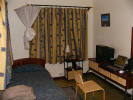
Single room #1 in the Aero Club of East Africa
The rooms have again been improved. The only point that needs being mentioned is that sometimes you have to let the hot water flow for an inordinate time, occasionally longer than 5 minutes, before you actually get warm water. I ended up taking a cold shower, but as I was finishing, the water slowly became warm. They have no ring pump here, so if the supply is at the far end of the building and nobody has recently used warm water, then this happens. The same, even worse, can happen in the Fig Tree camp and in many other places in Kenya. I personally don't mind, one just needs to know how to handle this.
Time to go to bed. First thing I did when I entered the room was to close all 4 window panes carefully, which requires some dexterity because of their strange English design, but it worked. I closed them for two reasons: 1. the street noise, and 2. the mosquitos, although I have yet to see one. But after the rainy season there are bound to be some, so I will use the mosquito net anyway.
Lots of appointments today. First I visited Colin, the boss, and Marilyn, his secretary, who run the aeroplane, to shift my appointment for a check flight because of appointment collisions. Tomorrow 10:30 is the time.
I also saw the aeroplane already from their window, a Cessna 182 named 5Y-ATS (Five Yankee Alpha Tango Sierra). It looks very good, like new. It was crashed and rebuilt and now has a new engine and propeller too. Max rpm is now 2,400, rather than 2,600. I'm sure you'll like it. It's the ideal light plane for Kenya, very strong and beautiful.
Then, of course, I took a taxi again and went to Rasuls to get the jeep. It is as good as ever and has, fortunately, shed the tires it came with. Now it wears the Kenyan standard tires, which are not perfect, but much better. The problem is the resistance, or the lack of it, to acacia thorns.
Went to the doctor to get a medical examination for flying, only to find that the 87 year old doctor I used to go to has retired. So I went to another one and was found to be in good health. Both doctors are old Englishmen who have seen much more of the Kenyan history than I have.
Then I went to the former Director of Civil Aviation, which has renamed itself to the Kenya Civil Aviation Authority (KCAA), to get my flying license renewed. They even have a copier now! Will get my fresh license tomorrow, so we're all set.
In the morning I drove to the KCAA to collect my license, only to find that it wasn't ready yet. It took another half hour of waiting to get it.
That upset my entire schedule, so I tried to move the next appointment, but that also failed because of telephone problems (numbers changed without my knowledge, etc.). So I had to drop one point from my plan and returned to Wilson Airport for the training and type checkout flight that I could not shift.
The flight was interesting. Among other things I tried an emergency landing down in the Rift Valley and made it pretty well, i.e. hit the best spot for landing. No, I didn't actually hit it and land, that would be an unnecessary risk. Before touching down in the bush, the exercise is broken off, power reapplied, the landing flaps retracted, and the aeroplane climbs out on its own power, which hadn't actually failed.
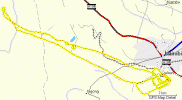
Training flights, everything to the left of Ngong is the Rift Valley
When you read this, it means I have had a good Internet connection, the one at Langata Link, a small business village at the road to Langata, which is a beautiful western suburb of Nairobi.
On the way there I stopped at the Barclays ATM in the supermarket at the entrance to The Carnivore, a famous open air restaurant, only to find that it was out of order. I will have to drive to the airport, which is on my way to Amboseli, to get some money.
I find the typical cattle species here very impressive. The horns of the bulls are incredibly huge. I could see them tonight much closer than I would want, but I would prefer to see them on a field, rather than crossing the streets of Nairobi at night. But a big herd of these cattle crossed the road in the middle of the night, and I had to wait for them to cross.
Finally I had done all the tasks that I had to do in Nairobi and was now free to leave and enjoy a little bit of my vacation. I was short of money though and thought of passing by the international airport again to visit the ATM there. But I tried the one at the supermarket first and found that it now worked. Perhaps the failure yesterday was only caused by a temporary loss of connection.
I pulled the maximum of KSh40,000 from the machine and drove off to the Mombasa road. There wasn't much traffic, and the driving was mostly pleasant. I stopped at my favorite gas station before Athi River, filled the tank and bought some soft drinks. Then I continued down the Mombasa road and turned off towards Namanga in Athi River.
The road to Kajiado is fairly good and one of the few where 80 km/h can be driven. After Kajiado it gets even better—not a single pothole until shortly before Namanga.
Along the way I dropped in at a friend's place and was offered a nice lunch and some good information about the situation with the drought and the subsequent rains. The drought had been rather bad in many places in Kenya. Amboseli was hard hit, for example. People in the Kajiado area had to move their cattle to other places to survive or to slaughter them, just like in some areas much farther north, like Baringo.
They run a safari camp, but also do cattle ranching. They saved most of their cows over the drought and lost only two, but with a lot of effort like relocation. When I heard that, I proposed to concentrate on the safari business and drop cattle ranching altogether, perhaps leasing the grazing areas to somebody else if they wanted to have the cattle around, but the reply was that this is just mzungu talk (meaning white foreigner hogwash). For one, they really like cattle ranching, partly as a way of life. But for another, they told me that without the cows their neighbors, Maasai, wouldn't take them seriously any more. They would lose their social status along with the cows. They would be the odd man out in the area.
Amboseli didn't get very much rain, but it did get some, and it is still green. Many wild animals have dispersed and am now slowly beginning to move back. As the rains and the sources of water recede, the Amboseli swamp will become more and more attractive to the wildlife.
Zebras were severely affected. Many died and many had deadbirths, which may be their way to cope with a drought. But particularly hard hit were the hippos, which cannot move as far away from their resting places in the water as other animals, as they have to return there every morning. Amboseli may have lost half of its hippos during the drought. The elephants, I was glad to hear, managed the drought much better. They are clever animals and know where to go and how best to handle the situation.
Too late I left the place and continued to Amboseli. I would have loved to take one of the long, adventurous and beautiful routes, but at 14 o'clock that choice was no longer open, so I took the fastest way via Namanga and down the still reasonably well graded road to Meshenani Gate and into Amboseli.
Shortly after Namanga three young Maasai women were hitch-hiking with me to their homes a couple of kilometers down the road. They were a funny bunch, but couldn't speak English. I find this frightening. One would think that one of the first interest in education in a place like that would be to learn English. If they can't even do that, they are doomed in the longer run. If they can't speak English, I'd guess that they haven't learned many other things either, so they will be condemned to a very poor, unhealthy and perhaps unpleasant life. I'm always shocked when I find so poorly educated people. It is certainly not their own fault, probably more that of their parents. Only a secondary aspect was that I couldn't talk much with them, not anything meaningful anyway.
Just for fun I handed them the GPS and tried to indicate that they could see how we were moving, but I suspect the concept of a map was alien to them. I think they couldn't really grasp what the device was doing.
Along the way I met several giraffes, one big giraffe bull blocking my way by standing in the middle of the road, and some gazelles.
I reached Meshenani Gate early enough, took two hitch-hikers to Ol Tukai, asked about the status of Lake Amboseli, then drove right into the now dry lake. It turned out that a large part in the center of the lake was still soft, so I couldn't keep driving in 5th gear, had to shift down to 4th to keep going. That always worries me, because I fear to drive right into a swampy area at high speed, then get badly stuck, but the lake turned out to be dry enough to cross, just as I had been told.
Driving across the lake not only saves a lot of time, because it is a totally straight and totally smooth racetrack, but also spares me the very rough roads on the northern side of the Amboseli nature reserve. Thus my entry to Amboseli was entirely pleasant.
I dropped the two Maasai hitch-hikers at Ol Tukai, said hello to the research assistant, picked up the cook, who happened to be there, and then we drove to the campsite of the Amboseli Elephant Research Project (AERP). Currently there was no researcher in the camp, so Peter, the cook, Nkoshopu, the watchman, and I settled down around the campfire for a nice little dinner consisting of some brown rice and a vegetable curry that I always like a lot.
Before that, however, I had a shower. The shower consists of a small wooden enclosure with a bucket that can be pulled up by block and tackle and that has a tap and a shower head at the bottom. The water is heated up by a solar water heater during the day and is then poured into the bucket.
Being able to take a hot shower in the middle of nowhere in Africa is always an uplifting experience. And I needed one pretty badly, I was all sticky and dusty after the long drive.
Now my computer, my battery charger, my mobile phone charger and my camera battery charger are all connected to the solar battery of my tent, and I can type away happily.
Since this year Amboseli now has full mobile phone coverage, so you can reach me at any time if you need to, but only by SMS or, in urgent cases that require questions and answers, by calling me. I could, in theory, get an Internet connection as well, by buying a Kenyan SIM card and paying a data tariff, but that seems to expensive and awkward for now. Things will get even better soon enough, but the downside is that this will also take the adventure away. My personal nightmare is that I'm immersed here in the African bush, watching wild animals, and then my phone rings and somebody calls be because of some job-related issue. A horrible thought!
Of course I could switch the mobile phone off, but then one of my safari guests might have an urgent question, and I wouldn't want to miss that. And I also wouldn't mind an Internet connection, so I could upload this page daily. But that will take another couple of years, I guess. It is already possible, but too awkward and too expensive.
While I'm writing this in my tent in the evening, I listen to a pride of lions roaring nearby. I could distinguish at least three. And when I look into the sky, I see the Milky Way. Everything around here is totally dark, no light pollution. What a wonderful view!
To experience the drive and the landscape for yourself, you can repeat the tour on your computer. If you have Google Earth installed, click here, then follow the instructions at the end of this page.
I was woken up by an early sun ray that peeped in under the otherwise closed cloud cover and painted the landscape in a golden glow, particularly the big fever tree in front of my tent.
I hadn't slept deeply through the night, probably because I had drunk inordinate amounts of Kenyan black tea (chai) yesterday. Must cut down on that in the evenings, but I like the tea. It tastes different from all other brands and is typically Kenyan. Most Kenyans drink it with milk and sugar, which hits my taste as well.
As the sun disappeared again after a few minutes, I decided to skip the early morning game drive because of poor light for photos. The sun reappeared around 8:30 in full force, and even the mountain (Kilima Njaro) appeared shortly before that, after covering itself again in its usual cloud cap. Often it reappears in the evening sun and yields one of the most impressive photo backgrounds you can wish for.
I didn't do much during the day, but did go out for a little evening game drive. After watching some warthogs the sun disappeared behind a cloud bank in the west, and I found, not far from the camp, a pride of lions, a young male with only the beginnings of a mane, three adult females and three cubs, about a year old. Since one normally doesn't see lions every day, I thought that's a nice entry into Amboseli.
There was hardly any photo light, but I took one picture nonetheless, if only to prove that the lions were really there.
Did a game drive in the later morning, along Amboseli swamp, and saw several beautiful animals, particularly birds, like a fish eagle, that I could not photograph.
Later in the day elephants almost blocked the camp entrance. They had obviously been bathing in the swamp, as you can guess from their wet, black legs and underbellies.
They were apparently digging for the roots of a particular plant. They use their feet to kick out the root system, grab it with the trunk and beat it against their side to shake out most of the sand. Only then they eat it.
In the evening I found the lions again. They had caught something at night, because I saw some rounded bellies and two of them still gnawing on some bones.
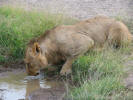
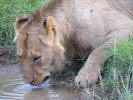
Young adult male lion drinking
I had stopped my jeep right next to the little pond. Some time later the male got up and walked straight to me. I actually had the hand already on the window crank, because I didn't at first understand why he came so close, until he began to drink.
Today I drove out only in the afternoon, particularly since the elephants came to the camp in the morning.
I came across a Vervet monkey mother with her dead child. She groomed the dead baby, turned him from one side to the other, and ate stones. The sound of the stones cracking between her teeth was gruesome.
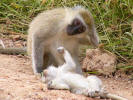
Vervet monkey mother with her dead child
I thought for a while about why she ate stones. Hypotheses are that she had been there for a while and was hungry, that she tried to drown her emotions with the cracking noise or the pain, or that she was simply very confused.
Then I drove north in the direction of the dry Lake Amboseli and checked a trail that isn't used much, on the far side of the swamp. I saw some hippos in the water, three bustards, a pair of crowned cranes and many other animals, particularly quite a few elephants.
In the evening I rushed back to the Amboseli Serena Lodge to fill up the tank for tomorrow's drive back to Nairobi, then back to the camp, and took a nice shower in the last rays of the evening sun.
Tonight the first guests will arrive, so I have to head back to Nairobi to collect them from the international airport. They arrive only after dark, but to reduce the risk of not being there in time I took the track with the most traffic back, again via Namanga, rather than my favorite, much lonelier one.
On the way back I saw this bird. He was being fed with insects by one of his parents, but he looked already fully grown to me.
Later along my way I saw many giraffes and even between the little towns along the Namanga – Kajiado road I saw a couple of ostriches crossing the road. Ostriches are also farmed in the area.
I arrived at the Aero Club in the afternoon and collected the room keys for my friends, who arrived in good mood and with their complete luggage in the evening. We collected their jeep on the way back and made it to the Aero Club.
After a good breakfast in the club we set off for a supermarket, then the main entrance of Nairobi National Park, where my friends equipped themselves with the smart cards required for all KWS nature reserves. Then they set off for a drive through Nairobi National Park, while I continued to Langata Link to get another Internet connection and do a little bit of work.
In the afternoon I drove to the international airport to collect Thomas, who came from Madagascar. Two hours later Peter should arrive, but I thought I would drive Thomas to the club, so he can already socialize with the other three, who should by now be back from Nairobi National Park.
However, there was a huge traffic jam along Mombasa Road. We tried to drive around it, but those streets were, of course, also jammed. Eventually we had to make the decision to drive back to the airport, because otherwise I would miss Peter. So we both collected him and only then drove back to the Aero Club. At that time the traffic jam had, fortunately, disappeared.
In the evening we happily sat in the club's restaurant and had a good dinner.
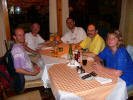
Dinner in the Aero Club of East Africa
The three who had been in Nairobi National Park told their story, we did a bit of planning for the next morning and some bookkeeping.
We got up at 6:00, sat at the breakfast table at 6:30, and drove out at 7:30 o'clock, which, I think, was not too bad. After breakfast we joined the townward traffic jam, but soon enough we were on the Mombasa Road, heading for Mtito Andei, half way to Mombasa, perhaps 250 km.

Down the Mombasa Road to Tsavo West
After the initial bit the road turned excellent, and so we reached Mtito Andei already at noon. Then we entered Tsavo West and headed for Ngulia Lodge. I had never driven the Mombasa Road by car and had never been to Ngulia Lodge either, so it was mostly new for me.
Tsavo at first showed only bush country without any visible large animals, until we got closer to Ngulia Lodge. Then we saw two fighting waterbucks and some other animals in a fascinating landscape, before arriving at the lodge.

Giraffe in a typical Tsavo West landscape
We asked for the room prices and found that the lodge was quite expensive at $200 for a double room per night in the high season. But we were able to get a good discount beyond the normal low-season discount of 20% after a little negotiation. We were also still in time for lunch, so we set down at the table first and enjoyed the good lodge food.

Oliver, Martina, Dietmar, Peter, Thomas at lunch
In the afternoon some of us went out for a little game drive, which was unexpectedly successful. Among other animals we saw many elephants drinking, bathing, and playing, and also a group of hippos in a little pond.
At dinner time we saw a leopard that was fed by the lodge and a porcupine.
After this full day we sank into our beds early and slept a little longer than last night.
The next morning we got up early, had breakfast, and then set out for Mzima Springs. Along the way we stopped at the hippo pond again.
Then we continued to Mzima Springs and walked along the upper two lakes.
After leaving Mzima Springs, we saw several Kudus again, but none of them was close enough to take a really good photo. They are very shy animals.
We also saw our first Grant's gazelles and also the first Coke's Hartebeest.
Along the track we met a group of elephants, but these were very shy and irritated by our presence. We were already a bit too close for comfort, but we had already stopped and couldn't go anywhere else if we wanted to see these elephants.
The elephants didn't move, didn't eat, initially showed clear signs of being weary. They stood in a defense formation and had stopped eating. When we decided to go away after a few minutes, the biggest one ran after us as if it wanted to pretend that she had driven us away.
These animals have been seen only by a part of our group, as Dietmar, Peter, and Thomas were eager to climb a small volcanic crater. This is about one hundred meters high, consists mainly of cinder and lava bombs and is the origin of two small lava flows. Also the view from the top was very nice.
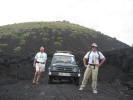
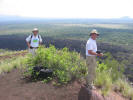
Peter and Thomas before climbing the crater; at the top
Some hyraxes live in the lodge compound.
From a vantage point at the top of the cliffs we could see for approx. 200 km over the uninhabited areas of Tsavo.
I took a photo of a Marabu stork in flight, and I later saw a ground squirrel in the lodge compound.
In the evening the leopard appeared again. We made our plan for the next day, decided to be at the breakfast table already at 6:00 o'clock and went to bed early.
We rose early too, had a quick breakfast, then set off for Amboseli.
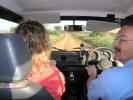
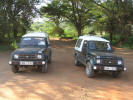
Dietmar and Martina on the road; our two jeeps
We saw elephants along the way and reached Chyulu Gate fairly early. However, the procedure of paying for an extra day we had stayed, but not paid in advance, was rather awkward. The smart card system appears to be idiotically designed and extremely inflexible. It took at least half an hour to check us out.
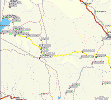
From Tsavo to Amboseli
If you have Google Earth installed,
click here, then follow the instructions
at the end of this page.
The drive to Amboseli was quite beautiful, particularly in the area around Finch Hatton's camp, where we saw lots of zebras and other wildlife in the green grass, illuminated by the morning sun. Somewhere around here we saw Mt. Kilimanjaro for the first time.
Then we reached a barrier and learned from the police officer there that neither the convoys nor the practice of forcing cars to take on an armed guard had been abandoned, as I had wrongly heard earlier. We tried to resist, but it became clear that they never wanted to abandon this system of extra income. The guard later demanded a tip when we arrived. At least we were not forced to wait for the afternoon convoy at Chyulu Gate, so it seems that the convoys are voluntary.
We arrived at Amboseli's Kimana Gate shortly after noon, and there the smart card procedure was even worse. They apparently always had to use temporary cards in addition to our smart cards, those expire after one month, and their reserves of temporary cards had mostly expired. So they had to use, for example, a citizen card for me and entered 21 days, rather than 3, to get to the same total. In Africa many things seem to have an insidious tendency to go wrong. I only pity the gate crew for having to deal with an adverse electronic system that makes their life difficult. It was obviously not their fault.
After arriving at Ol Tukai Lodge, our plan was to check it out first, then drive on the few hundred meters to the cheaper Amboseli Lodge to compare, but we were able to negotiate a decent discount and stayed at Ol Tukai Lodge without even looking at the other one. Ol Tukai is certainly the better lodge, particularly with the better food, so everybody was happy, and the price was a good compromise.
In the afternoon we even went out for another game drive and saw lions two times. First we saw two young adult male lions in the grass savannah near the northern end of the swamp, and later we saw the pride of seven that I had already met last week. Here a few photographs of other animals I saw.
The next morning we did another game drive, beginning already at 6:15 o'clock and now following the more common practice of having an early morning tea, a game drive, then the full breakfast afterwards.
Some more photographs:
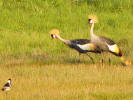
Crowned cranes with three chicks

Elephant in front of Kilimanjaro
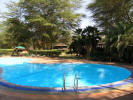
The swimming pool of Ol Tukai Lodge
Every day the elephants were around or in the camp. I had to be careful when I wanted to enter my tent, because an elephant could be right behind the bush next to it.
We always made two game drives a day, the one in the morning usually beginning at 6:15, the one in the afternoon at 16:00 o'clock. We kept seeing lions almost every day.
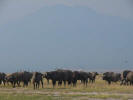
Buffalos in front of Kilimanjaro
On our last day we drove out to the western side of the park to follow a new track we had seen before. On our way there we saw this hippo, as it came out of the thick bush.
We also found two new tracks to complete my growing self-made map of the Amboseli game drive paths.
On our last evening we sat together and planned our return route to Nairobi and the next one to Nakuru.

From Amboseli to Nairobi via Lenkisim Mission – Osilalei – Mashuru – Imaroro – Kajiado
We had planned for breakfast at 7, departure at 8 o'clock, expecting a total travel time of about 6 hours. We set off as planned and drove across the meanwhile dry and totally flat and empty Lake Amboseli.
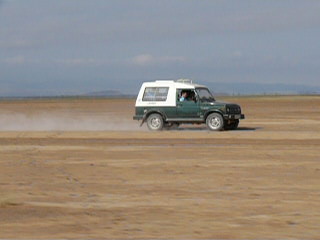
Click here to watch a video (WMV, 667 KB)
We checked out at the gate, but then drove back to leave the nature reserve on a different route that led us first to Lenkisim Mission. There we stopped, found the missionary, and were invited very friendly to a round of good and tasty drinking water.
At the entrance I took a photo of this wasp nest. It is still unclear to me what the wasps did there. They moved their wings slightly, but not enough for any significant cooling. Perhaps these were just guarding the nest, but I didn't see any others fly in or out.
Unfortunately the later part of the route led us over a road (Osilalei – Mashuru – Imaroro – Kajiado) that had been good when I last drove on it, but was now essentially destroyed by water, probably mainly during a recent year with a lot of rainfall. Thus it took us 9 hours, rather than 6, but eventually we made it back to the Aero Club of East Africa.
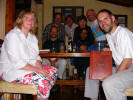
Back in the Aero Club of East Africa
The next morning we slept a little longer, then had a good breakfast and set off for Nakuru. Four of us took the two jeeps, the other four climbed into the aeroplane, a Cessna 182 with four seats.
The flight was very nice. To the north there were some clouds and haze, so we flew westerly and into the Rift Valley, where the weather was nice. We overflew Mt. Longonot, a volcano, and looked into the crater, then over Lake Naivasha and Lake Elmenteita to Nakuru Lanet airfield. We had a strong tailwind and arrived in Nakuru already after about 45 minutes.
In Nakuru we added a little over 20 l of petrol to top up the tanks.

Thomas refuelling the aeroplane
We visited Asma's relatives, who live near the airfield and sent an SMS text message to the jeep crew with a description and a waypoint showing our position, and they found us easily a little while later.
After being treated to a very fine spiced tea and some food, we said goodbye and drove to the nearby west gate of the Lake Nakuru nature reserve, then over a beautiful forest hill path to Lake Nakuru Lodge.
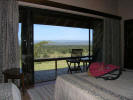
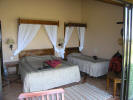
A room in the Lake Nakuru Lodge
At the lodge we moved into our rooms, but soon set out for an evening game drive.
The next day we did an early morning game drive and a long afternoon game drive. Some photos:
We even saw several of the white rhinos that have been introduced to the nature reserve.
We started out in the morning after the usual good breakfast and drove slowly around the lake. On the way we again saw several rhinos and many other animals including the rare Eland and the funny Hyrax.
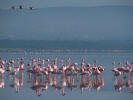
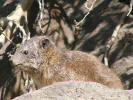
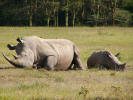
Flamingos; Hyrax; Rhino mother with child warming up in the morning sun
On the way out of Nakuru we passed by the Internet Café run by our friend Red and dropped in to check our email and to upload this web page. It is a busy and impressive business.
In Nakuru we also enjoyed the atmosphere of a real African town. (Nairobi isn't so typical.) But soon we took off and moved north to Baringo.
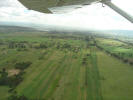
Taking off from Nakuru Lanet airfield, see the lake on the left side, the town on
the right.
We flew a little detour through the Kerio Valley, a western side valley of the Great Rift Valley. It has a steep western edge, along which we flew.
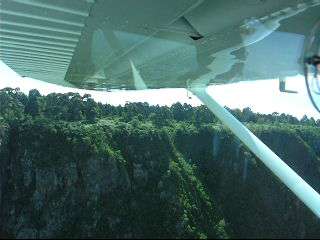
Click here to watch a video (WMV, 2.64 MB)
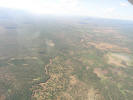
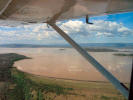
Crossing the Kerio Valley; approach to Baringo
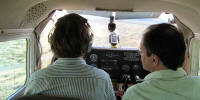
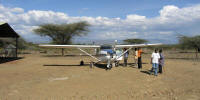
Final approach to Baringo airfield; landed
We moved into a fascinating house with a veranda and a cat walk leading to an elevated platform (on the left side in the photo). Thomas actually slept out there and could almost have touched the grazing hippos at night. We shared the airy interior with a few friendly bats, which flew in and out at night and slept hanging from the thatched roof during the day. Because of its gothic touch we called it the witch house.
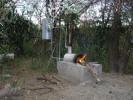
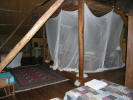

The source of hot water; double bed in the witch house; bat hanging from the roof
Lake Baringo is a sweet water lake in the Rift Valley. The area surrounding it is arid and difficult to use for agriculture.
However, Baringo is known for the highest number of observed bird species in the whole of Kenya. The lake is also the home of hippos and crocodiles.
We moved into Roberts' Farm, which used to be a camp site, but has long acquired bandas (huts) and also a little restaurant, the Thirsty Goat, which provides a good variety of simple food and was quite good enough for us. Nobody felt the urge to move into the adjacent Lake Baringo Club, a standard lodge that is a lot more expensive. Only the lodge's swimming pool lured a few of us over for an hour or two of swimming and sunbathing.
We used the morning for a boat ride on the lake and across to the islands and the rest of the day to be lazy and prepare for the long drive that was planned for the next day.
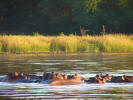
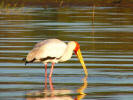

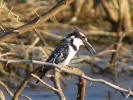



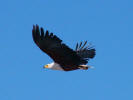
Hippos; Yellow-billed stork; two of 5 indigenous species of Kingfisher; fishermen;
Goliath heron; nocturnal bird; Fish eagle
On our boat trip we fed the fish eagles and tried to take photos when they caught the bait.

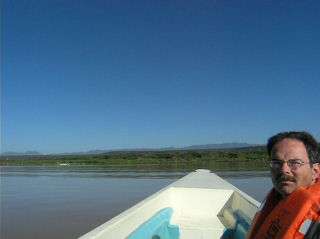

Click here to watch a video (WMV, 931 KB)
We got up very early in the morning, loaded the two jeeps, and then had a quick breakfast in the Thirsty Goat.
The flyers used the day for another flight through the Kerio Valley and a refuelling stopover at Nairobi Wilson airport.
The two jeeps headed north to Loruk, then east to Samburu on the most remote route of our entire journey, via Tangulbei – Churo – Mugie – Sukuta lol Marmar – Kisima – Lodungokwe – turn south before Wamba – near Ngotogongoron (school ruins) – Samburu west gate – Samburu Oryx airfield to the Samburu Lodge.
The flyers had a nice lunch in the Aero Club while their plane was refuelled. Then they set out for Samburu as well, flying to the east of Mt. Kenya.
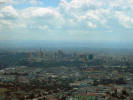
The city of Nairobi seen from the south after takeoff
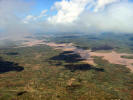
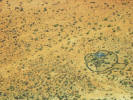
Masinga reservoir (Seven Forks); a Samburu manyatta in the semi-desert
Before the flyers arrived at the new Samburu Oryx airfield, they flew some distance towards Wamba to look for the jeeps, but couldn't find them. It turned out later that at that time the jeeps had actually been approaching the point where the plane turned back, but were just out of sight at the time. The road had been unexpectedly bad, like other roads before, and it took them two hours longer than expected.
But in the late afternoon the jeeps arrived at the new airfield, and we all rejoined and moved into the lodge.
The time in Samburu was a very good one, both for game drives and for enjoying the expensive, but very comfortable lodge.
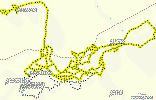
Game drives in Samburu (yellow) and Buffalo Springs (white).
(This map does not contain the arriving and departing tracks.)
We saw elephants often. Sometimes they crossed our way and made us stop. The photos below show an elephant mother with child who crossed our path and walked very close to the car. We would not drive so close, but when the elephant chooses to approach us without threatening us, then we don't start the engine and stay where we are.
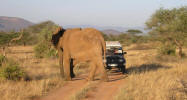

Mother elephant with child crosses our way.
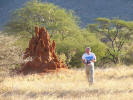
Thomas returns from photographing a termite mound
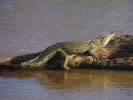
A crocodile basking in the sun


Vulture-headed guinea fowl; Kingfisher
The original idea was to have a little more time for resting during the three full days in Samburu, but it turned out that some of us even preferred a third game drive in the late morning.
Thomas and I made a flight to Lake Turkana, the former Lake Rudolf, to the Oasis Lodge at Loyengalani.

Samburu – Loyengalani
If you have Google Earth installed,
click here, then follow the instructions
at the end of this page.
Due to the strong wind from the southeast we flew very high, above the clouds, on our way north (yellow), and fairly low on our way back (white). We flew along the southeastern shore of the huge lake, and Thomas took some interesting aerial photographs. I hope to show one here soon.
The landscape is mostly semi-desert, apart from some mountain rainforests, and the area is hot. Even now, during the coolest time in Kenya, the air temperature was about 35°C.
The Oasis Lodge is the last one that is still operating today. It has an illustrious history of V.I.P. guests, among them the Rolling Stones and some famous actors and actresses.
The Oasis Lodge is built around a hot spring that feeds not only the lodge's water system, but also the two staggered swimming pools, through which the water flows into the lodge garden. The lower pool is a bit cooler than the upper one.
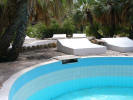
The staggered swimming pools of the Oasis Lodge
Loyengalani is easy to reach by plane, but driving there is almost impossible. The owner of the lodge recently had to take his jeep there from Nairobi, and it took him three days and 7 flat tires.
In fact most of the first flight to Lake Turkana was above the clouds, so we couldn't actually see the landscape underneath. Now we can experience that too.
Even the nicest time comes to an end, and so we got going early in the morning again. It was a beautiful sunny morning, and on the way to the airfield we were stopped by three cheetahs, apparently a mother with two almost adult kids.
After solving a battery problem and starting the aeroplane with the help of a car battery we set off for Nairobi again.
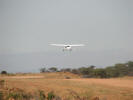
Takeoff from Samburu Oryx airfield
The flyers arrived after a beautiful, smooth, and fast flight around Mt. Kenya, while the drivers made their way via Isiolo, Nanyuki, and Thika and arrived in the late afternoon.
Sadly Thomas and Asma had to leave us to fly back to Madagascar and to visit friends and relatives, but the rest of us prepared for our last trip, to Masai Mara, the next morning. We also left the aeroplane behind, because it would not be very useful on our last trip.
Oliver, however, who had arrived early in the aeroplane, decided to use the afternoon to take a flying lesson on Wilson Airport.
After the usual early breakfast in the Aero Club of East Africa we drove out on the already known route via Dagoretti Corner to the Naivasha road.
But then we turned off to the left, into the Rift Valley. The road wends its way down the steep slope of the eastern edge of the valley, where we had a magnificent view across the Rift Valley and on the Mt. Longonot volcano.
In Mai Mahiu we turned off to the west and began to cross the Rift Valley, which is about 50 km wide here. We drove over the foot of another volcano, Mt. Suswa, and climbed out of the valley on the other side, reaching the town of Narok after a stretch of very bad, decayed road that had once been paved.
In Narok, about halfway to Masai Mara, we took a break, ate and drank a little, and filled the tanks of the jeeps. Then we drove the last remaining paved road, that was also already seriously decaying, and finally entered the gravel tracks that led us to the Masai Mara nature reserve, where we were greeted by the usual wealth of wildlife.
As we were driving towards our lodge, we saw a chain of rain clouds to the east and north, and while we were still driving towards our destination, the Fig Tree Tented Camp, it began to rain.
Fortunately the rain was not very heavy where we drove, so it didn't cause us any problems. After a beautiful drive a pride of lions stopped us before we even reached our lodge. We watched them for a while, then continued to Fig Tree, where we were welcomed with the usual friendliness.
We moved into our new, spacious and very comfortable tents and took showers to wash off the dust and prepare for a nice dinner, which concluded the travelling day.

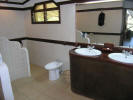
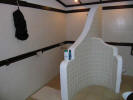
The spacious tents with porch, bathroom, and shower
Masai Mara is the most famous of the Kenyan nature reserves. It is actually the northern part of the Serengeti, most of which is in Tanzania.
[The spelling of the word Masai in the name Masai Mara with only one a is theoretically wrong, but is in widespread use, so in this text the word Maasai will be correctly spelled with aa, but the name Masai Mara will be spelled with just one a. Maa is the language of the Maasai. Both words contain a long a that is normally written as a double a.]
Masai Mara is very rich in wildlife, and we added several new species to our growing list of mammal species that we had seen in Kenya.

Mombasa train, a big millipede
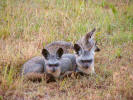
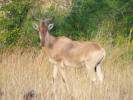
Bat-eared fox; Coke's Hartebeest
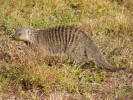
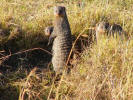
Banded mongoose, one of the two mongoose species we've seen
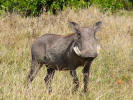

Warthog; White-bellied Bustard
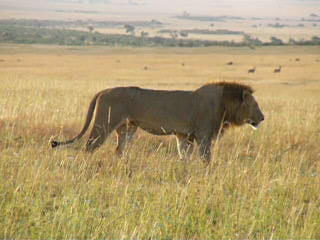
Click here to watch a video (WMV, 1.61 MB)
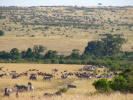
Herds of Zebra, Topi, and some gazelles carefully moving to the river to drink
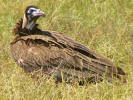

Two different species of vulture
In Masai Mara we saw a pride of lions hunting in the afternoon. Two of the 5 females were decidedly meager and badly in need of food. Perhaps this was the reason why they already begun to hunt in the afternoon.
The lionesses stalked a small herd of about two dozen wildebeest, then one of them attacked to drive the animals towards the other lionesses. However, the gnus were extremely quick and gallopped away at very high speed, while splitting into two groups. They were either lucky or far-sighted enough not to run into any of the other lionesses that had taken their positions on the sides. I've never seen gnus run so fast.
We set out early, because we already knew that the road was bad, but somehow it appeared more bearable this time.
We made it to Nairobi in reasonable time, arrived in the afternoon sun, and settled down in the Aero Club for our last night in Africa.
In the morning we had enough time for a last breakfast in the Aero Club, then we returned the two jeeps and were taken to the airport in good time for our flights. Only Peter stayed behind and spent the rest of the day in the Aero Club, because his flight with Emirates via Dubai would leave late at night. The idea to take a flying lesson caught on, and he also booked a flying hour to make the best of the remaining time.
At the airport we met Asma again, as expected. Her flight left shortly after ours, and so we had a little time to sit together and chat, before we had to go to the gates and board the planes.
The flight, this time conducted by Kenya Airways, was uneventful. The aeroplane that took 5 of us back to Amsterdam was a comfortable Boeing 777 that wasn't full.
In Amsterdam Schiphol we split up again to our different connecting flights to Germany and arrived at home well before midnight.
A wonderful African safari has ended. The memories will be with us for a long time, and I'm sure that some of us will return to Africa one day.
To experience a flight or drive for yourself, you can re-run it in Google Earth as follows.
Remarks: The virtual camera doesn't exactly follow the flight path for flights that you can see as a colored line. Instead it follows a point under that line a few miles ahead and 4,000 m above the ground. Hence the virtual aeroplane appears to climb and descend as the ground ahead rises and falls. This is one of the peculiarities of Google Earth. For this reason, if you set the altitude in Google Earth too low (somewhat lower than 4,000 m), you will fly into mountains and get stuck. No, even in Google Earth the aeroplane cannot turn into a mole and fly underground.
If in this text you find any typos, orthographic errors (even small ones), ungrammatical sentences, wrong or illogical information (like wrong names of birds), if you want me to write more details about something in particular, or if you want one of the photos in full resolution (usually 1,600 x 1,200 pixels), please click on the email sign below and write to me. Many thanks!
Copyright © 2006-2023 Hans-Georg Michna.
Private homepage – Hans-Georg Michna
Kenya travel reports: 1999, 2000, 2002, 2003, 2004, 2005, 2006, 2007, 2008, 2009, 2010, 2011, 2012, 2013-Goma, 2013, 2014, 2015, 2016, 2017, 2018, 2019
Kenya Safari Travel Plan, Kenya 1980-2000 photos
hits since 2007-11-01
Free PHP scripts by PHPJunkYard.com